Entries in Mid-Century Modern (58)
Mid-Mod Wowzem at Nevada State Museum, Las Vegas
From Dennis McBride at the Nevada State Museum, Las Vegas:

The April 24 opening reception for the Mid-Modern Las Vegas exhibit at the Nevada State Museum was a hit, drawing more than 130 people. The exhibit had been eagerly anticipated by Las Vegas’s community of Mid-Modders, as well as architects, historic preservationists, and realtors. The museum’s docents served a buffet from Mid-Century Modern dishware and several of them dressed the part. Many of those who attended the reception also dressed from the 1950s and ‘60s. Among the notable guests were realtor “Uncle Jack” LeVine; artist and Mid-Mod collector Diane Bush; Atomic Age Alliance founders Mary-Margaret and Carey Stratton, whose restored home in Paradise Palms was featured in the exhibit; Las Vegas Night Beat publisher Bill Schafer; realtor “Downtown Steve;” and curators from the Las Vegas Springs Preserve and the University of Nevada, Las Vegas.
In addition, Bill Mitchell, his wife, Barbara, and son Scott flew in for the reception from Florida and New Jersey: Bill is the son of Jay Florian Mitchell, whose historic photographs of Mid-Century Las Vegas compose most of the exhibit. Steve Cochran, grandson of Mid-Century Las Vegas designer and builder Lee Cochran, attended with his family. Lee Cochran’s 1964 Mason Manor home development is featured in the exhibit; homeowners from Mason Manor were also on hand to meet the Cochran family and talk about the history of their homes.
 Scott, Barbara and Bill Mitchell
Scott, Barbara and Bill Mitchell
 Ray and Steve Cochran
Ray and Steve Cochran
Mid-Century Modern Las Vegas is the last big exhibit the Nevada State Museum, Las Vegas will present before its 2011 move into a new building at the Las Vegas Springs Preserve.
 Nevada State Museum, Las Vegas Director David Millman and Mid-Century Modern buff
Nevada State Museum, Las Vegas Director David Millman and Mid-Century Modern buff
 Diane Bush studies the Pyrex
Diane Bush studies the Pyrex
 Studying more of the Exhibit
Studying more of the Exhibit
 Dennis McBride and Tom Dyer
Dennis McBride and Tom Dyer
 "Uncle" Jack Levine with some of his favorite buildings
"Uncle" Jack Levine with some of his favorite buildings
Mid-Century Modern Las Vegas at the Nevada State Museum: How the Exhibit Works
Dateline: Las Vegas
Guest Blogger: Dennis McBride, Curator of History, Nevada State Museum, Las Vegas

When Lynn asked me to guest blog about the Nevada State Museum’s upcoming Mid-Century Modern Las Vegas exhibit, she wanted me to share how I chose the images that will be exhibited, and how I decided what examples of Mid-Century domestic and decorative arts to use in the cases.
Museum patrons who see finished exhibits don’t know what goes into building displays--they either like what they see or they don’t, and that depends upon how well or how badly the curator has put everything together. I work with a great deal of intuition, but once in awhile--accidentally, it seems--I work deliberately. Lemme see what I can tell you about our new exhibit.
To be frank, I didn’t know very much about Mid-Century Modern architecture and style until the Lynn and the museum sponsored the Mid-Century event last October 3. I got hooked, and wanted to do something with material that no one had seen before, or had not seen in more than a generation. The museum has in its archives the photograph collection of J. Florian Mitchell, who was renowned as a photographer in New York in the 1920s, ‘30s, and ‘40s, before coming to Las Vegas in the early 1950s.
When I came to work here in 2007, part of my self-appointed task was to reorganize the photo collection and make it more accessible. When I dug through Mitchell’s thousands of prints and negatives in the museum’s vault, I was astounded at the breadth of his Las Vegas subjects, which included images photographers ordinarily wouldn’t care much about recording. In addition to hotels, casinos, and Las Vegas celebrities, I found images of long vanished shopping centers, banks, motels, restaurants, schools, and government buildings. Nearly all of these were taken in the 1950s and ‘60s, during the height of the Mid-Century Modern movement. I saw images that gave me an entirely different idea of what Las Vegas once looked like, and how perfectly it fit into the Mid-Mod style for a relatively brief period of time. How could I publicize these photos in a way that would inspire Las Vegans to look at their city’s past in a different way? Motivated by Lynn’s enthusiasm, I started planning a Mid-Century Modern exhibit of Las Vegas’s past.
With so many images to choose from, how would I pick what best represented Las Vegas architecture in the 1950s and ‘60s? Lynn made an initial search through the collection, and I made a second and third, mining the negatives for what I thought people might like to see. Rather than choose images of familiar landmarks, I largely chose photos of buildings that are either vanished or so changed that their present appearance bears no resemblance to the original. For example, the original McCarran International Airport today seems mysterious, alien, and beautiful in its Mid-Modern simplicity. The original rotunda of the Las Vegas Convention Center seems far more substantial than the present stack of boring blocks. Maude Frazier Hall at UNLV sits behind its lawn looking cool, elegant, and more inviting than the gravel lot that replaced it last year. With these and other images, I’ve tried to show that Las Vegas then was far more architecturally daring and beautiful than it is today.

So far, so good for the images--but I also wanted the exhibit to ground patrons in that period in a way that two-dimensional images cannot. I needed artifacts that people could relate to personally. I decided to include an exhibit of Mid-Century “domestic and decorative arts.” Think dishes, pots and pans, utensils, ashtrays, vases, cook books and recipe boxes. How would such objects convey a sense of Mid-Century modernity? Through their shape, their material, and their use. When people think of the 1950s and ‘60s from this perspective, they think of Pyrex, Tupperware, and Melmac; they think biomorphic, boomerangs, parabolas, rounded squares, domes; they think pink, turquoise, and chartreuse. We took those shapes and colors as the frame for the exhibit hall, and then I went on a six-month search through Goodwill, Salvation Army, Savers, and whatever yard sales I drove by for exhibit items. I built a case of colorful melamine dishware; fanciful Pyrex casseroles, carafes, butter dishes and nested bowls; bright orange Tupperware measuring spoons; a set of Russel Wright’s American Modern dishes in chartreuse, with their strange biomorphic shapes; a vintage Teflon-coated sauce pan with a sweeping lid; a garish green-and-gold leaf dish from a California pottery; and a black, understated Hyalyn pottery bowl.

These are artifacts to which people can relate: Grandma cooked green-bean casseroles in a Pyrex bowl just like that Moon Deco piece with the big red dot; Mom kept a pair of Scandinavian Modern candlesticks just like those on the sideboard in her dining room; my uncle, who smoked Chesterfields, kept an ashtray like that on his nightstand; we thought nothing of eating chicken rolled in bleached white flour and fried in Crisco.
That’s how we did it, and we hope you like it. Mid-Century Modern Las Vegas will be the last major exhibit the Nevada State Museum presents before its move in 2011 to new digs at the Las Vegas Springs Preserve.

Mid-Century Modern Exhibit at the Nevada State Museum, Las Vegas

This is going to be a wonderful event. Dennis McBride, Tom Dyer, Wes, Paul and the crew at the State Museum have been working on this exhibit for months. Some of the decorative arts on display are from Dennis' own fabulous Mid-Century Modern collection.
The photos, of course, are from the wonderful J. Florian Mitchell collection that we have talked about here and that were part of the inspiration for our wonderful Mid-Century Modern day last fall.
I am hoping that Dennis can do a blog piece about choosing the photos and items for the exhibit so stay tuned.
In the meantime, be sure to RSVP to Stacy Irvin as you don't want to miss this wonderful homage to Mid-Century Modern Las Vegas!
Dennis McBride talks Las Vegas History and More!
Looking for info on the upcoming Las Vegas High School program? Click here
Aside from being one of the early inspirations for the Classic Las Vegas Historic Collection, Dennis McBride is one of the leading authorities on the history of Southern Nevada, especially the history of the building of Boulder (Hoover) Dam and Boulder City.
He has spent his life collecting stories and memories of Southern Nevada in the 20th Century. As a native Nevadan, he has had a front row seat to the changing landscape of the Valley over the course of his life.
He is the Curator of History at the Nevada State Museum in Lorenzi Park and he was kind enough to share his thoughts on the history he has collected and much more:
As a native of Southern Nevada, how has Las Vegas changed since you were younger? How do you feel about the changes.
Still a City of Neon
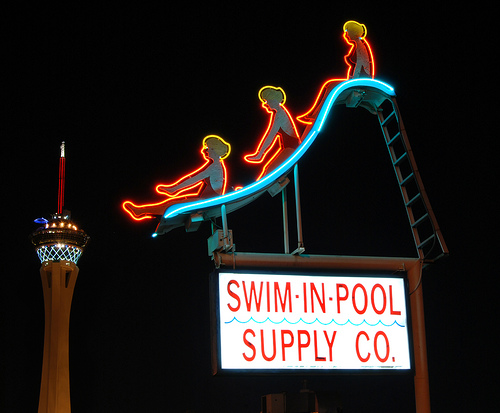
Will the Swim-In-Sign ever be repaired and put back up?
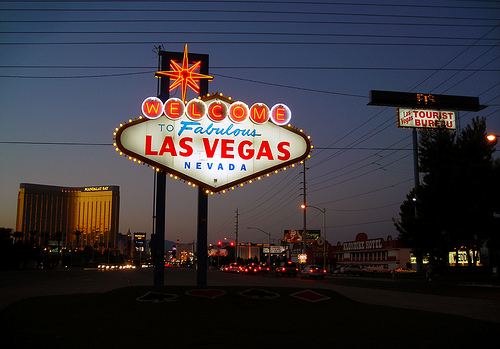
A tribute to Betty Willis and 50+ plus years of marketing
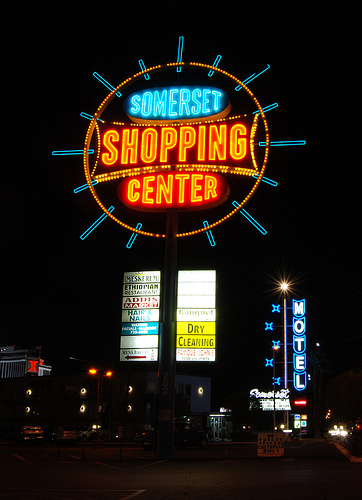 Endangered
Endangered
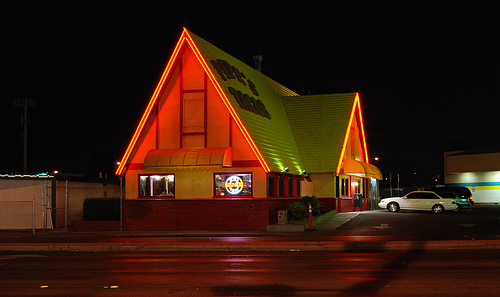 Pepe's Tacos great redaptive reuse of a former IHOP
Pepe's Tacos great redaptive reuse of a former IHOP
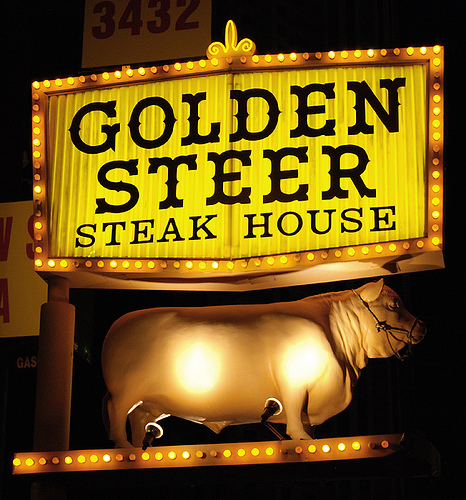 Endangered
Endangered
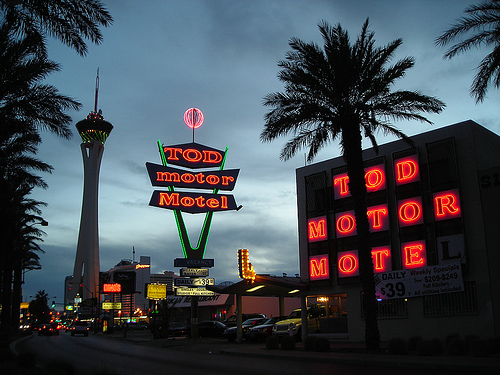 Tod Motor Hotel still going strong
Tod Motor Hotel still going strong
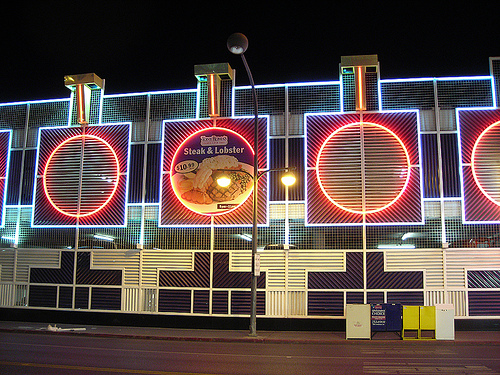 Fremont Hotel Parking Garage
Fremont Hotel Parking Garage
Thanks to Allen Sandquist for letting us use these images



